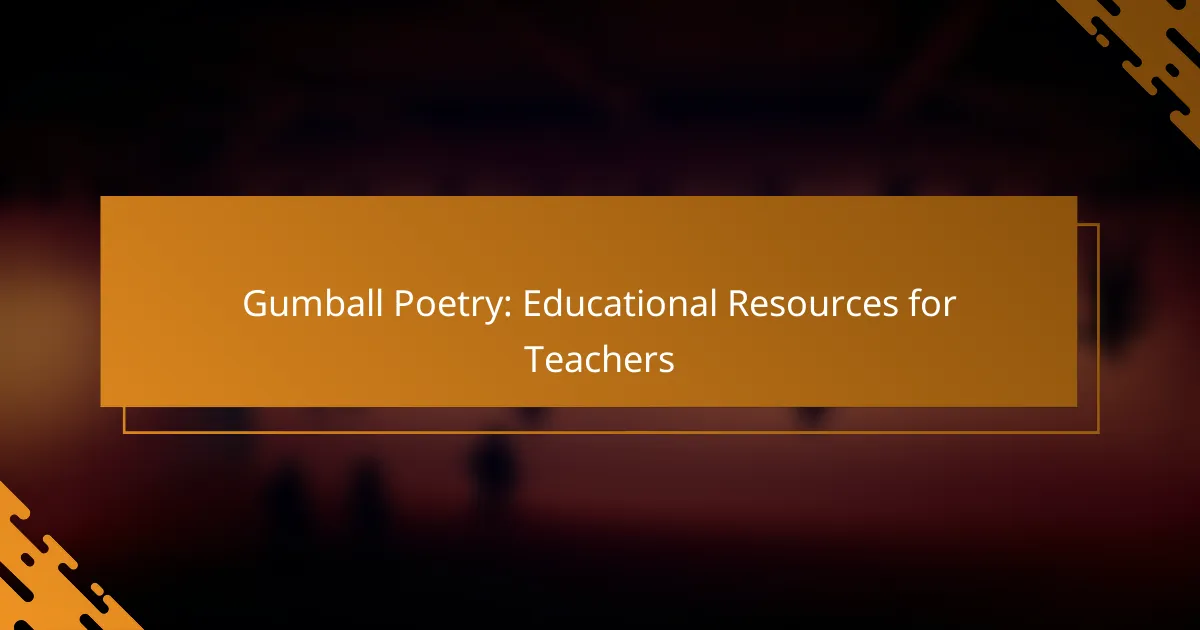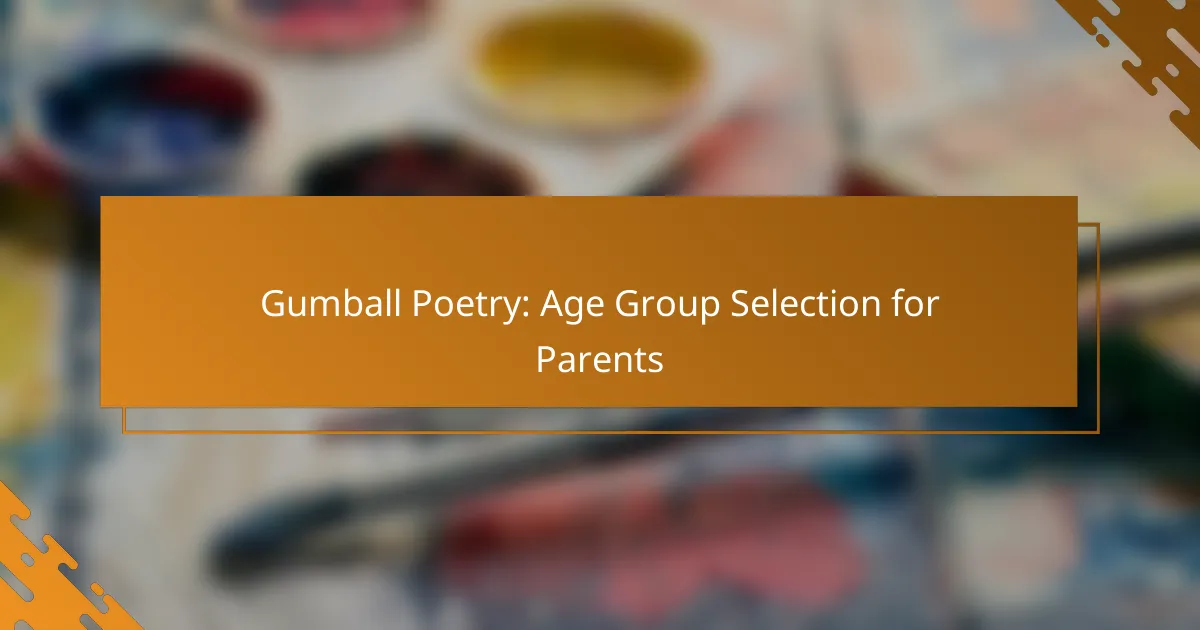Gumball Poetry offers an engaging and interactive way for students to explore poetry creation, fostering creativity while developing essential literary skills. Educators can access a wealth of resources, such as printable worksheets and online lesson guides, tailored to accommodate diverse learning styles. By utilizing assessment tools like rubrics and peer reviews, teachers can effectively gauge student understanding and creativity in their poetic endeavors.
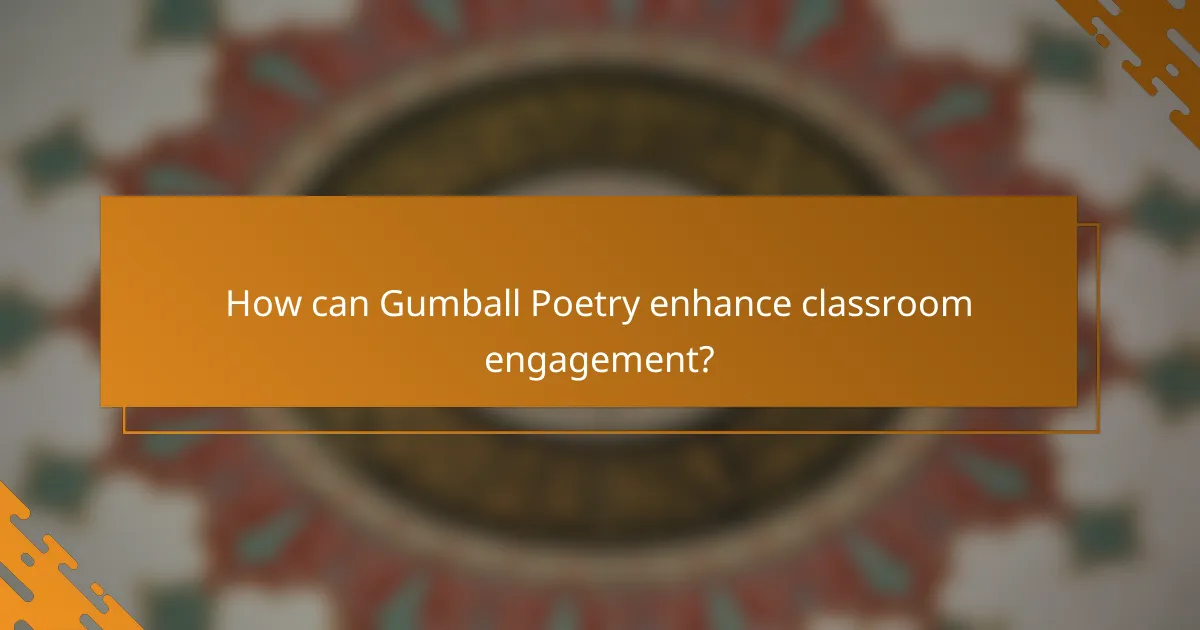
How can Gumball Poetry enhance classroom engagement?
Gumball Poetry can significantly boost classroom engagement by making poetry creation interactive and fun. This approach encourages students to express their creativity while learning essential literary skills.
Interactive lesson plans
Interactive lesson plans using Gumball Poetry can include activities where students create poems based on colorful gumball themes. For instance, each color could represent a different emotion or theme, prompting students to write lines that reflect those ideas.
Consider incorporating technology by using digital tools where students can visually arrange their gumball poems. This not only enhances engagement but also helps students develop their digital literacy skills.
Creative writing prompts
Creative writing prompts can be tailored around the gumball concept, such as asking students to describe their favorite gumball flavor or to write a story about a magical gumball machine. These prompts can stimulate imagination and encourage unique storytelling.
To further inspire creativity, teachers can provide a list of gumball-related words or phrases that students must incorporate into their poems. This strategy helps students think critically about word choice and poetic structure.
Group activities
Group activities centered on Gumball Poetry can foster collaboration among students. One effective method is to have students work in small teams to create a collective poem, where each member contributes a line or stanza based on a chosen gumball theme.
Additionally, consider organizing a “Gumball Poetry Slam” where groups present their poems to the class. This not only builds confidence in public speaking but also creates a supportive environment for sharing creative work.
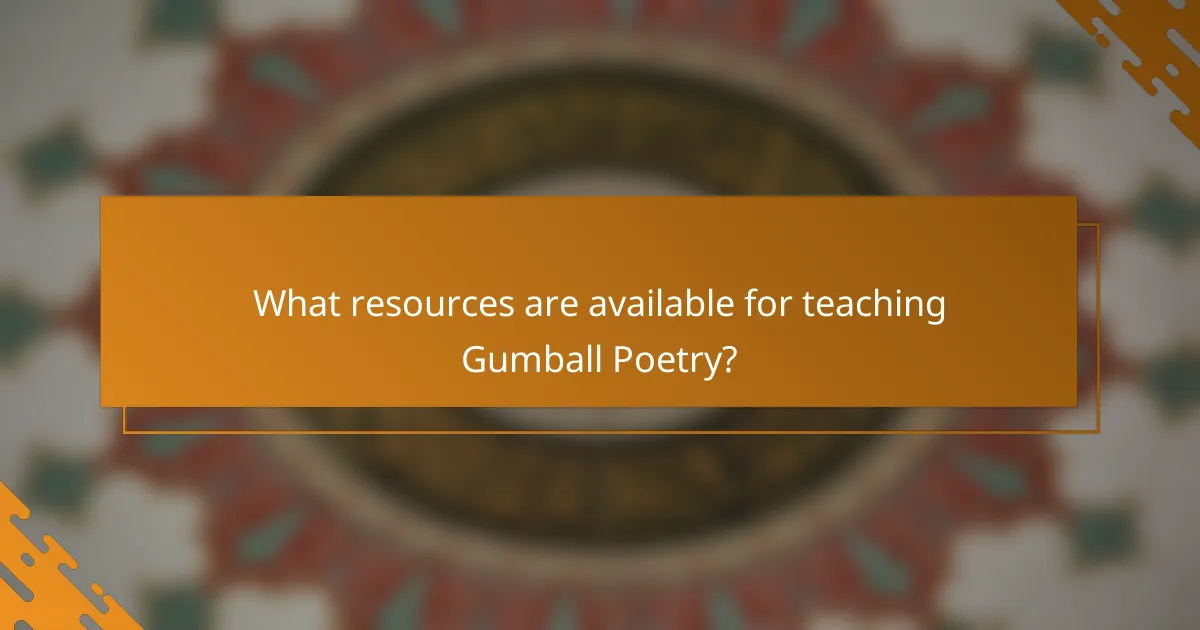
What resources are available for teaching Gumball Poetry?
Teachers can access a variety of resources to effectively teach Gumball Poetry, including printable worksheets, online lesson guides, and video tutorials. These materials cater to different learning styles and can enhance student engagement in poetry writing.
Printable worksheets
Printable worksheets are essential tools for teaching Gumball Poetry, providing structured activities that guide students through the creative process. These worksheets often include prompts, examples, and spaces for students to draft their poems.
When selecting worksheets, look for those that incorporate visual elements, as Gumball Poetry is often colorful and playful. Consider using worksheets that allow for both individual and group activities to foster collaboration.
Online lesson guides
Online lesson guides offer comprehensive plans that outline objectives, materials needed, and step-by-step instructions for teaching Gumball Poetry. These guides can help teachers structure their lessons effectively and ensure that all key concepts are covered.
Many online resources also provide links to additional materials, such as sample poems and assessment tools. Utilizing these guides can save time and enhance the overall teaching experience.
Video tutorials
Video tutorials are a dynamic way to introduce Gumball Poetry concepts to students. These videos can demonstrate the creative process, showcase examples, and provide tips for writing engaging poems.
Look for tutorials that are concise and visually appealing, ideally under ten minutes, to maintain student interest. Incorporating these videos into your lessons can enhance understanding and inspire creativity among students.
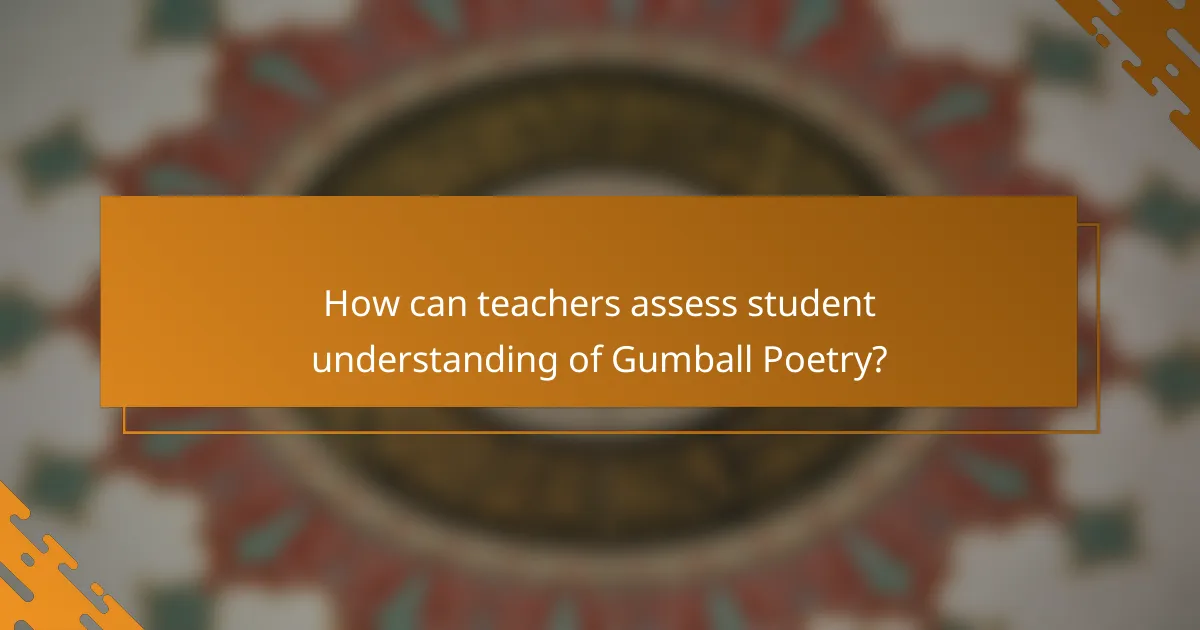
How can teachers assess student understanding of Gumball Poetry?
Teachers can assess student understanding of Gumball Poetry through various methods, including rubrics and peer reviews. These tools help evaluate students’ comprehension of poetic elements and their ability to express creativity in their work.
Rubrics for poetry analysis
Rubrics provide a structured way to assess Gumball Poetry by outlining specific criteria such as creativity, use of imagery, and adherence to poetic form. A typical rubric might include categories like content, structure, and language, each rated on a scale from 1 to 4.
For example, a score of 1 might indicate minimal effort, while a score of 4 reflects exceptional creativity and mastery of poetic techniques. Teachers should share the rubric with students beforehand to clarify expectations and encourage self-assessment.
Peer review frameworks
Peer review frameworks allow students to give and receive feedback on their Gumball Poetry. This process not only enhances understanding but also fosters collaboration and critical thinking. Students can use guided questions to evaluate each other’s work, focusing on aspects like emotional impact and clarity of expression.
To implement this, teachers can create a simple checklist for peer reviewers, including items such as “Does the poem evoke emotion?” and “Are the poetic devices effectively used?” This approach helps students articulate their thoughts and learn from their peers’ perspectives.

What are the best practices for integrating Gumball Poetry in the curriculum?
Integrating Gumball Poetry into the curriculum involves using this creative form of expression to enhance students’ engagement and understanding of language. Best practices include aligning activities with educational standards and ensuring that lessons are interactive and relevant to students’ experiences.
Cross-curricular connections
Gumball Poetry can be effectively linked to various subjects, such as art, science, and social studies. For example, students can create poems that reflect scientific concepts, like ecosystems, or historical events, allowing them to explore different perspectives while reinforcing their learning.
To facilitate these connections, consider collaborative projects where students work in groups to combine poetry with visual arts, creating colorful displays that represent their poetic themes. This approach not only enhances creativity but also fosters teamwork and communication skills.
Incorporating technology
Technology can play a significant role in enhancing Gumball Poetry activities. Utilizing digital tools such as online poetry generators or multimedia presentation software allows students to experiment with different formats and styles, making the learning experience more dynamic.
Encourage students to share their Gumball Poetry through blogs or social media platforms, which can help them reach a wider audience and receive feedback. Additionally, consider using apps that facilitate collaborative writing, enabling students to co-create poems in real-time, regardless of their location.
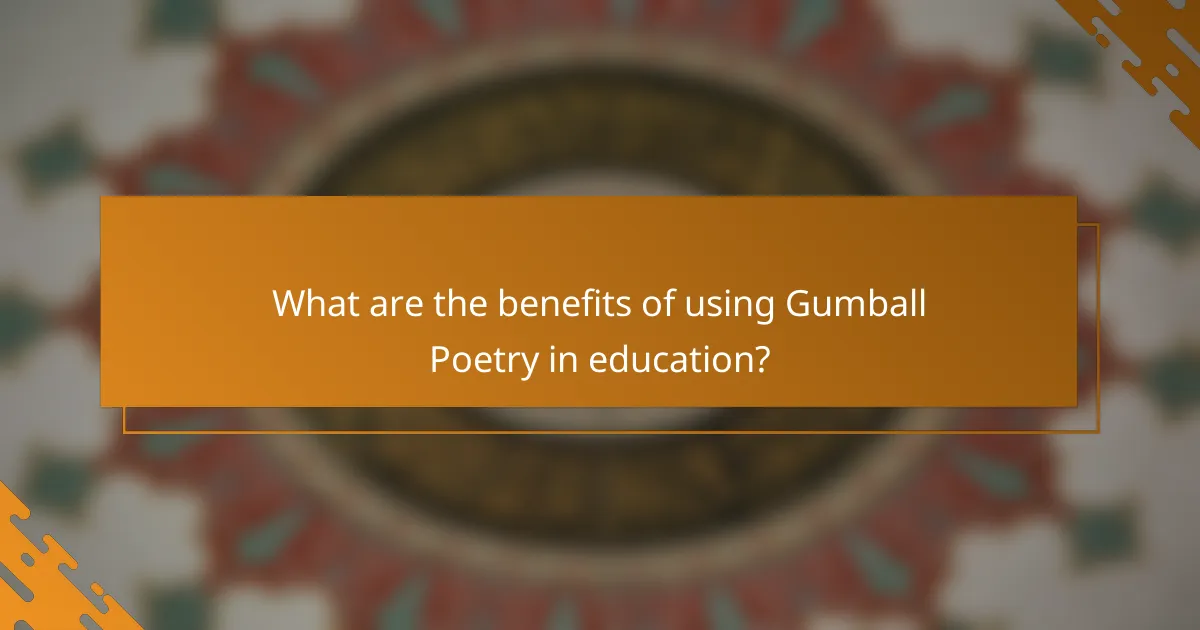
What are the benefits of using Gumball Poetry in education?
Gumball Poetry offers numerous benefits in education, including fostering creativity and enhancing critical thinking skills among students. This engaging format encourages learners to express themselves while developing their analytical abilities.
Improved creativity
Using Gumball Poetry in the classroom stimulates students’ creativity by allowing them to explore language in a playful manner. The structure encourages them to think outside the box, combining different ideas and emotions into their poems.
Teachers can enhance this creative process by providing prompts or themes related to students’ interests. For example, asking students to write a gumball poem about their favorite season can lead to vibrant and imaginative expressions.
Enhanced critical thinking
Gumball Poetry also promotes critical thinking as students analyze their own work and the work of their peers. This analysis requires them to evaluate word choices, imagery, and the overall impact of their poems, fostering deeper comprehension of language.
Encouraging peer reviews can further strengthen critical thinking skills. Students can learn to provide constructive feedback, which not only helps their classmates improve but also sharpens their own analytical abilities.
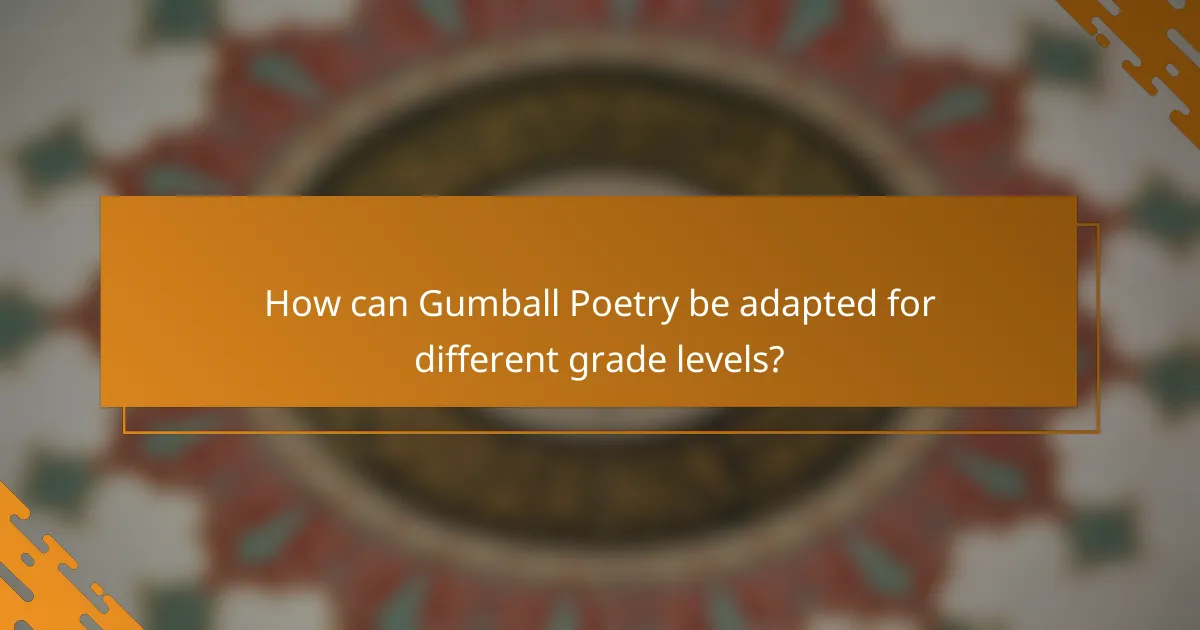
How can Gumball Poetry be adapted for different grade levels?
Gumball Poetry can be tailored to suit various grade levels by adjusting complexity and thematic focus. Teachers can modify the structure, vocabulary, and themes to engage students effectively at each educational stage.
Elementary adaptations
For elementary students, Gumball Poetry can be simplified by using familiar themes such as animals, seasons, or family. Teachers can encourage young learners to use basic vocabulary and short phrases to create their poems, focusing on rhythm and rhyme.
Incorporating visual aids, like colorful gumball illustrations, can enhance engagement. A classroom activity could involve students creating a gumball chart where each color represents a different theme or emotion, helping them visualize their ideas.
Middle school variations
Middle school adaptations of Gumball Poetry can introduce more complex themes, such as identity, friendship, or social issues. Students can be encouraged to use figurative language, such as similes and metaphors, to deepen their expression.
Teachers might implement peer review sessions where students share their poems and provide constructive feedback. This not only fosters collaboration but also helps students refine their writing skills and explore diverse perspectives.
High school extensions
High school students can take Gumball Poetry to the next level by exploring abstract concepts or current events. They can be challenged to write poems that incorporate research or personal narratives, blending creativity with critical thinking.
Encouraging students to perform their poems in spoken word formats can enhance their public speaking skills. Additionally, teachers can facilitate discussions on the impact of poetry in social movements, linking their work to real-world contexts and encouraging deeper analysis.
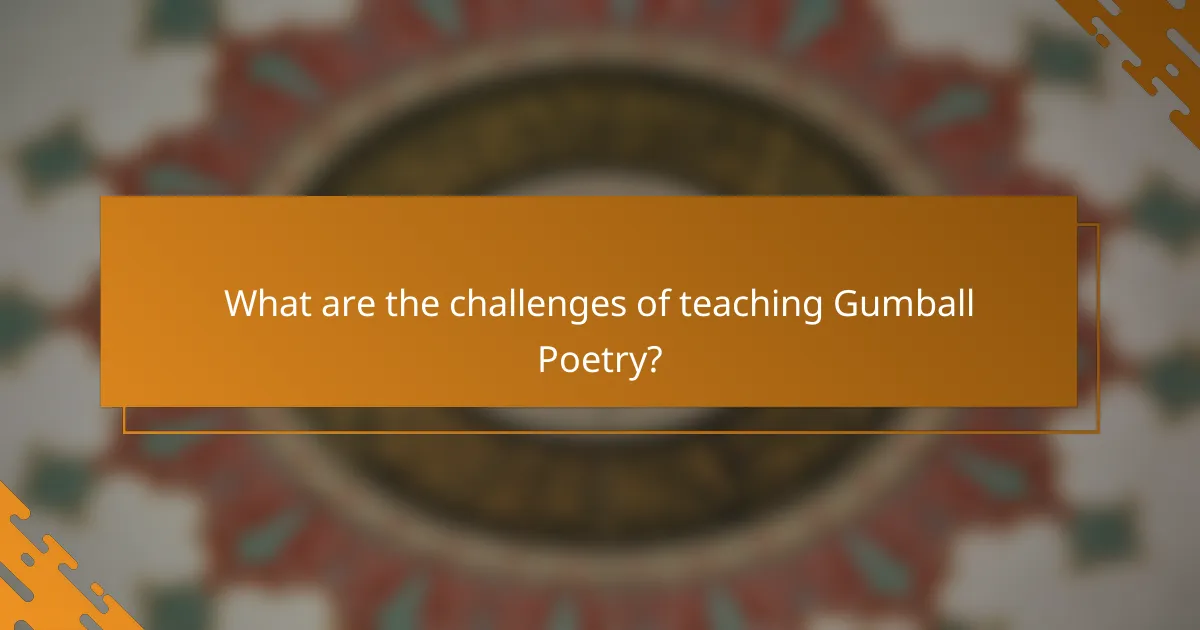
What are the challenges of teaching Gumball Poetry?
Teaching Gumball Poetry presents several challenges, including engaging students with the unique format and encouraging creativity within structured guidelines. Instructors must balance fostering individual expression while adhering to educational standards.
Engaging Students
One of the primary challenges is capturing students’ interest in Gumball Poetry, which relies on a playful yet structured approach. Teachers can enhance engagement by incorporating interactive activities, such as group brainstorming sessions or multimedia presentations that illustrate the concept. Using relatable themes or popular culture references can also help students connect with the material.
Balancing Structure and Creativity
Gumball Poetry requires a specific structure, which can sometimes stifle creativity. Educators should encourage students to explore their unique voice while adhering to the format. Providing examples of successful Gumball Poems can inspire students to think outside the box while still following the guidelines.
Assessment and Feedback
Assessing Gumball Poetry can be challenging due to its subjective nature. Teachers should develop clear rubrics that outline expectations for creativity, structure, and thematic elements. Offering constructive feedback that highlights strengths and areas for improvement can help students refine their skills without discouraging their creativity.
